Dogs use their teeth to get to the bottom of many issues, as that’s their only resource to relieve itchiness or other discomforts on their body. When you see your pup biting or chewing on their nails, it’s usually indicative of something bothering them around their paws. If this becomes a chronic problem, it could be a sign of something brewing.
Anytime your dog has odd behavior, it should be something you should keep an eye out for. If they are biting or chewing their nails, it’s also important to watch out for any other behavior that’s out of the norm, like eating less or not being as energetic around their family.
So what could cause a pet to have discomfort on their paws? While there are many possible issues, in this article, we will cover some of the most common reasons your dog may be chewing or biting her nails.
Why Do Dogs Bite Their Nails?
A dog’s teeth are like our fingers to us and are tools they use beyond eating. Since dogs do not have hands and fingers as we do, they rely on their teeth and mouth to scratch places they cannot reach with their paws. A dog biting and chewing is the same action as a human’s scratching and picking. They are trying to soothe or investigate something on the body that is causing them discomfort.
There are a few different things that can cause a dog to bite or chew at her nails. They may be too long, there may be something stuck in them, or it could be a matter of something more serious. This biting behavior can cause owners to be concerned if it happens a lot or starts to become very intense. Just like a dog obsessively licking a part of her body, constantly chewing on nails is not something owners should ignore, especially if it has been going on for a while.
A dog that is biting and chewing at her nails is trying to tell us that something in this area is causing them some form of discomfort. Owners can find themselves not knowing what to do and can become concerned about this behavior, especially if a pup starts to injure themselves by chewing too much. So what are some reasons behind this behavior?
General Reasons For Biting & Chewing
It’s Time To Visit The Groomer

A dog biting her nails is sometimes part of a natural self-grooming process. If a dog is chewing at their nails or paws, it could simply mean that they are in need of a nail trim. When a dog’s nails get too long, it can make regular daily activities more difficult. Long, overgrown nails can put pressure on the paw pad, causing discomfort and pain when they walk.
Severely overgrown nails can even begin to dig into their skin, causing severe pain and infections. Long nails can also increase the chance of nail injury, which can be incredibly painful. Regularly trimmed nails help to prevent any complications and keep your pup feeling her best.
In some cases, extremely fluffy dogs will be bothered by hair overgrowth on their paws which is another reason for chewing and biting nails. Some dogs have thick feathering around their paws and legs, which can become wedged between their toes. This could be comparable to the feeling of a thick string bothering your foot inside of your sock. It’s not unbearable, but it’s definitely annoying This can also be managed by regularly de-shedding your dog.
If you see your furry friend licking and chewing at their nails, the first thing you should do is check and see if it’s their way of telling you to make an appointment with the groomer or find a way to DIY at home. This is usually the least painful and cheapest thing to remedy, so make sure to start here first.
Allergies

Canines can get allergies too. Just like us humans, they can be triggered by many environmental factors. Allergies can cause incredible discomfort for your canine friend. Allergies of the skin are known to cause itching, swelling, redness, and pain in more severe cases. Some allergies your pup can experience include:
- Grass allergies: It is no secret dogs love grass. They love to roll in it, eat it, and investigate what surprises may lay underneath. Some unfortunate pups are known to have allergies to the grass they are exposed to each day. Pups will come in from their time outside and experience severe itchiness and resort to biting and chewing their paws for relief. Just as the itching begins to subside, they are exposed to the grass again on their next trip outside. Dogs can become truly miserable from grass allergies. You can typically help remedy this by using a pup shampoo for sensitive skin or a dog shampoo made of oatmeal.
- Food sensitivities and allergies: Food allergies can often present as skin redness and itchiness. While most pups will experience itchiness all over their body, they will also bite at their paws as well in an attempt to relieve their symptoms.
- Outdoor/seasonal allergens: Just like in humans, some pups experience seasonal allergies depending on the allergen that is present in the environment. These pups will often seem fine one day and become overcome with itchiness at certain periods throughout the year. Their feet can become especially itchy if the allergen is present in your grass.
If you think your dog is experiencing minor allergies, you can add Benadryl to her daily routine after speaking to your vet about its use. Benadryl is an antihistamine used to relieve the symptoms of minor allergies, so it has brought comfort to many pups experiencing itchiness from seasonal allergens.
The recommended dose for Benadryl in dogs is 1 mg per pound. (Example: 25mg for a 25-pound dog)
Skin Infections

The area between a dog’s toes is the perfect environment for an infection to brew. If you add moisture to the mix, such as licking the paws and nails, it’s a recipe for disaster. Once dogs experience itchiness or discomfort in an area, they will lick and bite at the area in an effort to “relieve the problem.” The more they bite and chew, the more damage they actually cause to the affected area.
This action will often lead to severe skin irritation and wounds on the paws that easily become infected with their exposure to dirt and germs on the ground. If the area around your dog’s nails and paws appears red and irritated, it’s best to contact your veterinarian for a visit before the situation gets worse. The vet will often get your pet started on antibiotics, send home a topical spray for the affected area, and an E-collar that will prevent your pup from any additional licking.
Another factor to consider is the possibility of foreign material in the paw or around the nail. Blades of grass, foxtails, or any other plant or stick material can easily become lodged in your dog’s paw. Household items can also make their way into those extremely sensitive areas. These items can often be hard for owners to see, and dogs will try to get them out by biting and licking excessively. This will often be accompanied by chewing at the paws, biting nails, swelling, redness, and limping. If you notice any of these symptoms in your dog, have them seen by your veterinarian as soon as possible.
Anxiety

While there are many symptoms of anxiety, chewing, and biting the nails can be a sign of anxiety or boredom in your furry friend. Humans often bite their nails or fingers when anxious, and it is no different for an anxious pup. Whether it is due to your absence, a change in surroundings, or out of boredom, nail biting can become a compulsive problem that can cause complications down the line.
If it seems like this always happens when your pup is left alone or without entertainment, you can try to offer them stimulating toys and activities. This may include a Kong toy with treats inside, a food bowl that entices them to search for the kibbles in hidden compartments, or a healthy bone to chew on while you’re away.
If your pup is displaying other signs of anxiety, such as destructive behavior, urinating in the house, pacing, panting, or any other concerning symptoms, it can be related to more severe anxiety disorders. Dogs can sometimes develop an obsessive-compulsive disorder with paw chewing, so if this is a chronic problem that you cannot seem to find relief for, give your vet a call. They can help you implement new actions to relieve anxiety and prescribe anxiety medication if needed. You may also want to consider CBD treats to help your dog’s anxiety.
Fleas & Ticks

Fleas and ticks like to hide out in dark crevices on our beloved pups. Ticks especially love the spot between the toes on their paws and can cause great discomfort by doing this. If you see your dog chewing at their nails or toes, make sure to check in between her toes and on the paw pads for any unwanted fleas or ticks. If you do see any ticks or unwanted pests in between their toes, it is always best to visit your vet for proper removal. Ticks can be tricky to remove completely, and parts of their bodies are often left behind on the skin in the removal process. Your vet can show you how to properly remove these unwanted friends.
Another condition that can cause itchiness is flea dermatitis. This is characterized by red and itchy skin with the current or previous presence of fleas. Fleas can trigger an allergic response that results in severe skin irritation and itchiness all over the body. If your dog has fleas and is chewing at her nails and paws, it could be due to this itchy condition.
Keeping your pet on monthly flea and tick prevention can avoid any secondary conditions from these pesky skin critters. There are many different routes you can utilize to treat fleas, and topical solutions are some of the most common treatment avenues for fleas and ticks.
Nail Injury
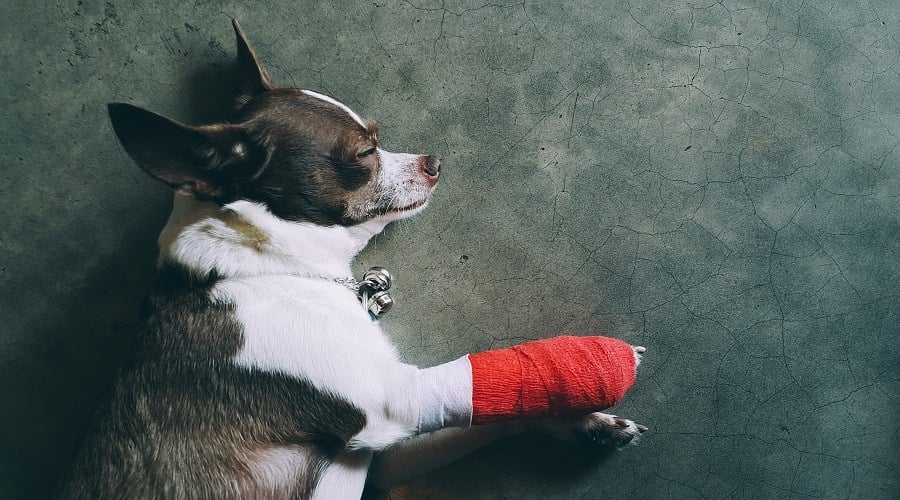
Dogs are not exempt from broken nails. Broken nails can be excruciatingly painful, and your pup may not know how to tell you what is wrong. With how active our dogs can be, they often experience nail injuries at least once throughout their lives. This can easily happen from getting their nail caught on things or nails getting cracked in different ways. This can often be incredibly painful, leading a dog to lick or bite at the affected nail in an effort to soothe the pain. Some other signs you may see associated with a nail injury are:
- Excessive nail biting.
- Licking the paw and nail.
- Swelling around nails and paws.
- Redness around nails.
- Blood on the paw or on the carpet where your pup stands.
- Limping or refusing to put weight on a paw.
- Paw sensitivity.
- Not allowing you to examine their paw.
- Emotional distress from the pain.
If you think your dog may have a nail injury, it’s important to have them seen by your veterinarian right away. These injuries are known to get infected quickly and can result in severe pain for your pup. If infections go untreated, they can be harmful to the overall health of your pup or even fatal in severe cases. This is especially true of the dog’s archnemesis – the foxtail plant when it gets lodged in a tender paw.
Skin Conditions & Mange
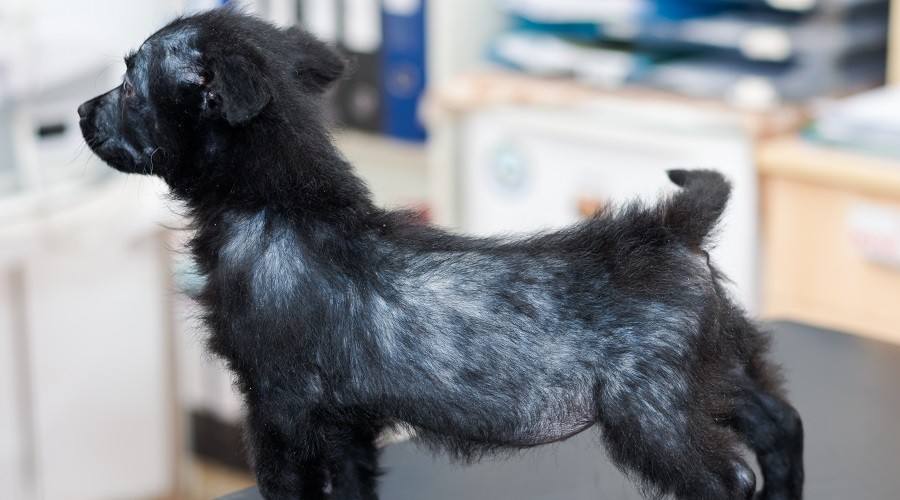
There is a long list of different skin conditions that can present around your dog’s paws and nails that can result in chewing or biting at nails and paws. One of these common skin conditions is demodectic mange, which can often be localized on the paws. This will often present as hair loss on the paws and legs, chewing at the feet, and possible secondary infections on the feet from chewing.
In order to properly diagnose this condition, your vet will perform a skin scraping. This involves scraping the skin with a small blade and looking at the skin tissue under a microscope. Once diagnosed, your pup can receive medicated baths, oral medication, or injections to help resolve the condition. It will depend on the severity of your pup’s case for which method of treatment the vet will choose.
Some other skin conditions that can result in canine nail biting and paw chewing are allergy dermatitis, yeast overgrowth on the skin, bacterial infections, and ringworm. Some of these conditions can make your dog very smelly, so they are a little easier to point out. It’s important to get your vet involved right away if you anticipate your dog has mange. You can also get an at-home allergy test for your dog from EasyDNA.
Growths On Paws
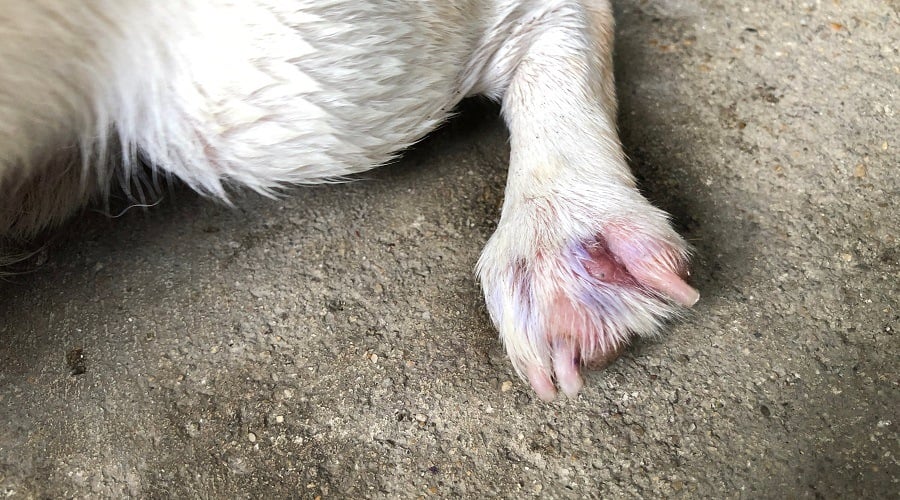
One of the less common reasons for chewing at the nails and paws is the presence of any growths or masses on the paw. Occasionally, dogs can develop interdigital cysts (cysts between their toes), masses around their nails, or abscesses on their nails from a previous injury. While lumps and bumps are less common, it’s important to be aware of them. If you see any concerning lumps on your pup’s paws, have your vet take a look ASAP.
Arthritis can also cause a pup to bite or chew on her nails and excessively lick her paws. This is not always as obvious as more recent injuries or issues. This can develop over time as your pup tries to soothe the pain she feels in her bones and joints. Always discuss nail biting with your vet to rule out underlying issues and help relieve your dog’s pain.
Frequently Asked Questions
Is it safe for my dog to bite her nails?
It is not safe to allow your dog to bite and chew on her nails a lot. While this may happen occasionally and be just regular self-grooming, it is not healthy behavior if it becomes obsessive. Most often, this behavior is a sign your pup has something causing them pain or discomfort, and you should make sure to find out what it is. This can quickly become a much more serious situation. Listen to your pup, and pay attention to her behavioral clues that something is wrong.
How can I stop my dog from biting her nails?
Talk to your veterinarian as soon as you notice this behavior. They will rule out a medical issue and offer guidance on treatment. You can provide your dog with a distraction, like a puzzle feeder, a long-lasting chew, or a new favorite toy. Make sure to keep her feet very clean, even if this means washing them every day. Keep up with nail clipping and consider taking her to the groomer if you need help with this part. You can consider a nail grinder for larger pups or those who do not like their nails clipped.
What should dog nails look like?
Dog nails should look similar in color. Discolored nails are unhealthy. Nails should not be dry, cracked, or peeling. They should not be longer than the paw and should just peek out a little bit. Nails that click and clack on the floor are too long. Oddly colored nails or those that look infected should be examined by a veterinarian.
Final Thoughts
Overall, your pup’s urge to chew and bite its nails is a way of telling you something is up. Whether it’s their time for a simple nail trim or a hint at something more, this action shouldn’t be ignored. While these 8 common conditions represent a good chunk of the reason your pup may be chewing repetitively, there are other reasons that should be examined by a veterinarian. What we present to you here is for informational purposes and not to be used as a substitute for veterinary advice.
The first step to diagnosing your pup’s issue is to take careful inventory of what their symptoms are. Whenever there’s any concern you can’t address, your next best option is to head directly to see your vet. The next time you find your canine friend chewing their nails or paw, consider these possible reasons above!




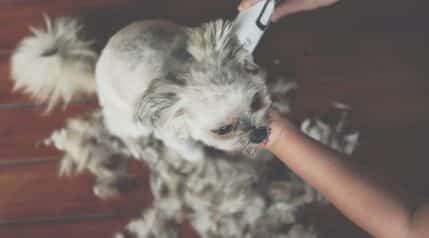
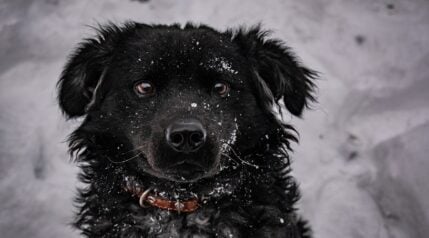
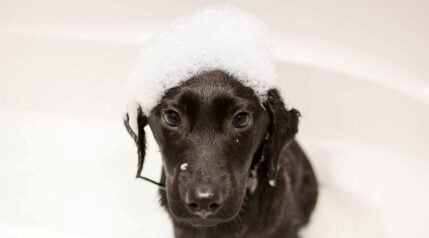
My pup is taken to see his doctor when he starts chewing on his nails, sometimes he ends up with antibiotics with a nail clipping. it is so the dog can be depressed or anxious when he starts chewing on his nails. So to cure the depression and anxiety we tried to take him riding in the car away from the house he enjoys that and we do get his nails clipped and sometimes they do put them on antibiotics because of an infection but today’s he’s getting a haircut tomorrow he’s seeing his vet for a nail clipping. thank you I’ve enjoyed your knowledge on animals, this has helped me out in the past I have been reading off and on articles and it sure has helped my little dog out.